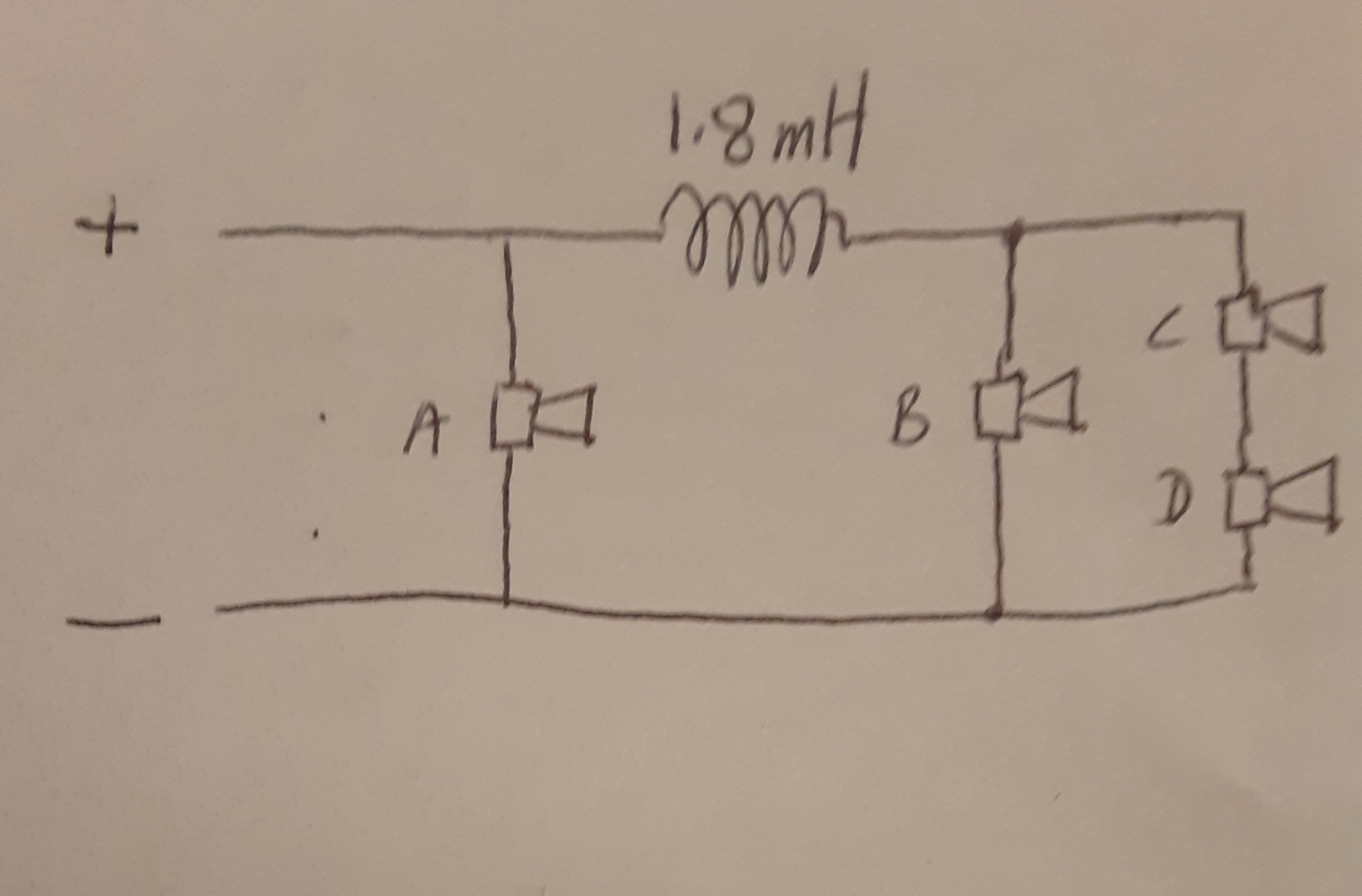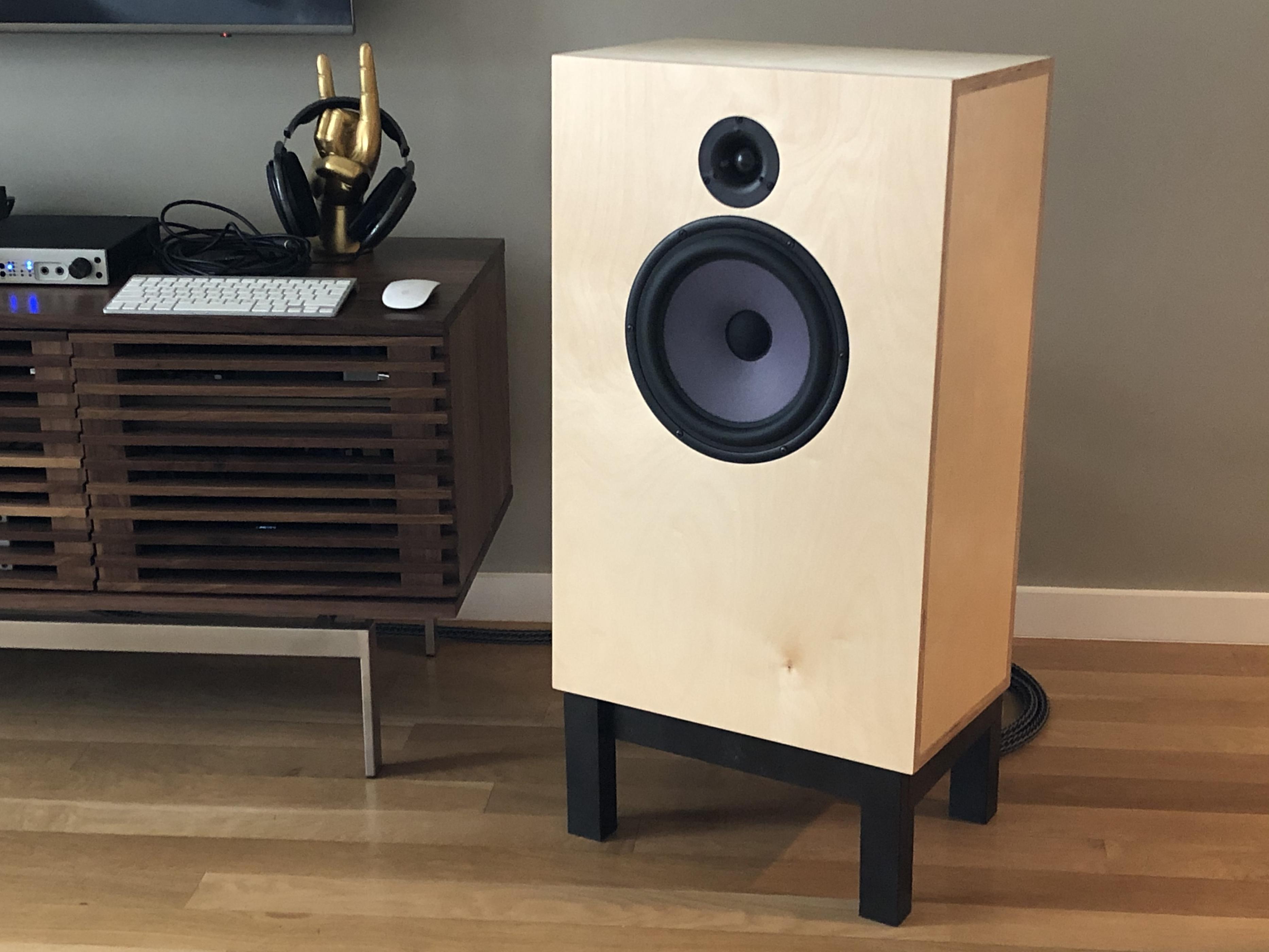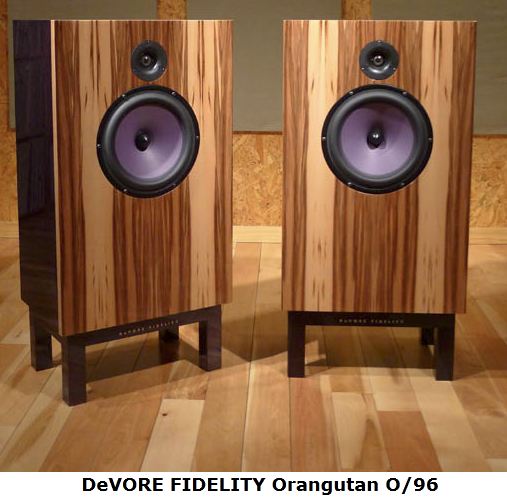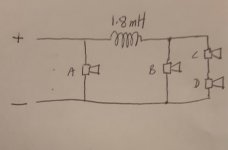I came across this design for a speaker with 4 identical 8ohm full range drive units with an inductor. Being crossover illiterate please could someone tell me what is happening to the 4 drivers
Attachments
Last edited by a moderator:
All four drivers operate at low frequencies. The inductor cuts off three of the drivers
above a certain frequency. The fourth driver is full range. This can give better imaging.
This is often called a 2 1/2 way crossover.
above a certain frequency. The fourth driver is full range. This can give better imaging.
This is often called a 2 1/2 way crossover.
Last edited:
Rayma, is it not a 1.5 way crossover?
Just I thought a 2.5 way, was a 2 way with additional woofer for BSC.
Just I thought a 2.5 way, was a 2 way with additional woofer for BSC.
Right, there's no tweeter. Two of the drivers are in series and work at a lower level, though.
Last edited:
If all 8Ω, the series-parallel section with the three drivers is rather pointless. Unless the two series drivers are polarity reversed and the designer tried to acquire some kind of directivity control.
I guess it is s mixture of array shading and BSC. The cutoff with this inductor value is around 470 Hz. I.e. it would be around the that frequency if the load was pure resistive. So it will be slightly different in reality.
Regards
Charles
Regards
Charles
The best DIY speaker in the world? - DIY Audio Projects - StereoNET
Hello all. This is where I found it. Whatever the validity of the claims, I was interested in the concept of the xover. What is the impedance seen by the amp, and what are the relative outputs of the drivers.
Ps. I left out the rweeter from the original diagram because it did not seem relevant to my question.
Hello all. This is where I found it. Whatever the validity of the claims, I was interested in the concept of the xover. What is the impedance seen by the amp, and what are the relative outputs of the drivers.
Ps. I left out the rweeter from the original diagram because it did not seem relevant to my question.
The description in the article makes sense, but does not match the drawn schematic of the 'final version' of the crossover.we put the top two (drivers) in series and run them fullrange.
we take the other two, connect them in series, but run these through a 0.05mH inductor. then connect these pairs in parallel to the amp.
this means that at high frequencies (where the frequency response is higher) only the top two are making sound. then when we go lower to the midrange, the other two kick in, and from there down it's all 4 drivers contributing.
Absolutely the worst thing I have ever seen at our beloved forum:

Become a light unto yourself with a simulator:
Software | Visaton
Import the odd project into the projekte folder and find out how it works:
2-Way Speakers | Visaton
But entertaining nonsense from a demented mind. 😀
Edit: thinking about it, I might actually be able to get this to work. But that's just me.

DIY Clones of commercial speakers
Become a light unto yourself with a simulator:
Software | Visaton
Import the odd project into the projekte folder and find out how it works:
2-Way Speakers | Visaton
But entertaining nonsense from a demented mind. 😀
Edit: thinking about it, I might actually be able to get this to work. But that's just me.
DIY Clones of commercial speakers
Last edited:
To be clear, it was a super tweeter and therefore not an essential addition to the quad arrangement of full range drivers.Ps. I left out the rweeter from the original diagram because it did not seem relevant to my question.
The article gives no explanation of the drawn crossover - it looks to be stuck on at the end of the article as an afterthought.
The drawn crossover makes no sense to me, however the description of the quad driver arrangement in the article does.
ah, I remember this one, it's cheap 8" dual cone PA speakers, relatively hi eff (`92db) in an OB config; frankly I think the guy on Stereonet forum is dreaming.....a prime example of Beranek's Law. It would make more sense if the series woofers were 4 ohms, & the one in parallel 8 ohms.
Yah, sips Coffee, the units after the bass diver and coil might add a bit of bafflestep:

Then add a tweeter.

The Morel CAT378 works well on a single capacitor apparently.
Then add a tweeter.
The Morel CAT378 works well on a single capacitor apparently.
Immediate reaction; abhorrence.
It looks like a simplistic attempt to discover, and a perception of, by chance, reaching Nirvana, and conveniently ignoring all the painstaking work done by highly trained individuals.
It looks like a simplistic attempt to discover, and a perception of, by chance, reaching Nirvana, and conveniently ignoring all the painstaking work done by highly trained individuals.
Except for that one time we decided to get on the sauce. The grandfather clock is still stuck on 4.Absolutely the worst thing I have ever seen at our beloved forum:
Except for that one time we decided to get on the sauce. The grandfather clock is still stuck on 4.
Aw come of it, AllenB! My great uncle opened the batting for Australia! With the Don and doudtless Bill Woodfull..
Bill Ponsford - Wikipedia
I am sure he liked the odd Beer after the match. And so do I.
TBH, me old mate, I always enjoy the long Test matches. England against Oz is just the highlight of the Cricketing Calendar for me
Ah well, 3 T20's will just have to do. No idea who will win. But Thanks for turning up. 🙂
(And Thanks to the Windies and Pakistan for keeping us Entertained this Summer.)
Ah well, 3 T20's will just have to do. No idea who will win. But Thanks for turning up. 🙂
(And Thanks to the Windies and Pakistan for keeping us Entertained this Summer.)
I came across this design for a speaker with 4 identical 8ohm full range drive units with an inductor. Being crossover illiterate please could someone tell me what is happening to the 4 drivers
From project page:
That is NOT what´s shown in schematic. 🙄we start by buying 8 of them - 4 for each speaker.
we put the top two of them in series and run them fullrange.
we take the other two, connect them in series, but run these through a 0.05mH inductor. then connect these pairs in parallel to the amp.
- Home
- Loudspeakers
- Multi-Way
- Could someone explain the effect of this crossover to me please.
